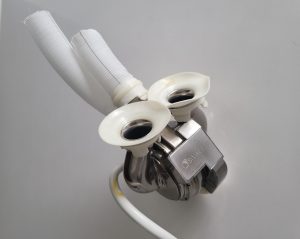Using magnetic levitation technology, the world’s first long-term artificial heart won’t wear out, age or break. It’s small enough for a child’s chest yet robust enough to pump life into an active adult, and it’s about to be implanted in human bodies for the very first time.
Back in 2000, when Daniel Timms was completing his mechanical engineering degree, his father suffered heart failure. It was an experience that would shape his life’s focus.
“For my PhD I decided to look at artificial heart technology as something that might be able to help him have a better life,” the Australian biomedical engineer told create.
Timms hails from a family where engineering solutions were dinner discussions. He and his father, a plumber, would often tinker with ideas to craft the right kind of heart pump.
“You can make pumps for pools, ponds and waterfalls,” he said. “This was just one for the body. Pretty early on, we had the conceptual design for the device that we’ve created today.
“We just never thought it would take 23 years to actually make it happen.”
Timms co-founded BiVACOR in 2008 in Brisbane, gathering a think tank of world-class engineers, medical minds and business leaders, all pumping their expertise into the total artificial heart (TAH) project.
In November 2023, the device finally received FDA approval for implantation in up to five patients in the US this year. This early feasibility study will evaluate TAH as a bridge to a heart transplant in people with biventricular heart failure. Timms hopes his device will be in bodies within months.
Australian recipients may be only a few months behind. In February, the federal government announced a $50 million Medical Research Future Fund grant to develop and commercialise the TAH. It’s one of the largest sums in the grant’s 10-year history.
“We have the opportunity to learn from surgeons, clinical staff and our artificial heart patients in the US, and bring that knowledge and the device back to Australia,” Timms said.
A pioneering beat
The demand for artificial hearts is extreme. Nearly 500,000 Australians live with heart failure, according to government figures. And each year, around 60,000 people are diagnosed with the condition and 60,000 are hospitalised for it.
But only around 100 patients undergo a heart transplant each year; many more never get the chance.
While artificial hearts are not new, until now they’ve been limited to pumps that help only left heart functions or models that echo a natural heartbeat with sacs and valves that cause mechanical wear, and hence are a stopgap rather than a solution.
“The BiVACOR TAH is the first device designed to replace an entire heart with a long-term solution,” Timms explained. “Nobody has done that before.”

The device’s heart – a magnetically levitated rotor – sits between two pump casings with impeller blades that control blood flow and allow for changes in the patient’s physiology.
In its current design, an external controller and batteries supply power to the internal device via a percutaneous driveline. Future iterations plan to implant the electronics, and charging will be done through the skin using electromagnetic induction technology.
Outdoing nature
More than just replacing human hearts, Timms hopes his device can outperform them. For starters, the body is less likely to reject an artificial heart.
“This device is titanium, an inert material, so the body doesn’t know it’s there,” he explained.
Being metal, the heart also won’t age, wear out or break.
And thanks to magnetic levitation technology, the spinning part inside the device is not in contact with anything but the blood, so there’s no mechanical wear, which means there should be little need for maintenance.
“Creating a device to implant in a patient is like building a motor for a car where you can’t pop the hood. You can’t easily go back in. This has to be very reliable. It needs to last a patient’s lifetime.”
Similar in size to an adult fist, the TAH is designed to be small enough to be implanted in many women and some children, yet robust enough to cope with a large adult who’s running or jumping.
Yet despite the technology and expertise involved in creating the TAH, it should actually be cheaper for heart implant patients than the real thing.
“The procedure to remove a natural heart from a deceased patient then transport it from one location to another is remarkably expensive, sometimes up to $US 1 million,” Timms said. “This device is off the shelf.”
A heartfelt pursuit
The TAH is one of a range of artificial organs under development, from eyes and ears to lungs and kidneys.
“If there’s an organ that’s failing, there’s an engineer trying to make one to replace it, that’s for sure,” Timms said.
With the artificial heart on the cusp of being commercialised, Timms is sad his father, who died just as he completed his PhD, isn’t here to see it. But he doesn’t think he’d be surprised.
“He’d just see our success as confirmation of what we already knew back in 2006. And I think he’d be phenomenally proud.”
Timms said his dad’s spirit has been a constant companion, driving him to bring his vision to life. After all, an artificial heart isn’t just about keeping blood flowing, it’s about keeping hope alive.
“Creating a device that could help people like him, and help keep others’ loved ones around, certainly kept me going,” he said.
“The natural heart can have a heart attack at any time, whereas this artificial heart will just keep spinning. When people have this device implanted, they aren’t going to die from heart failure.”